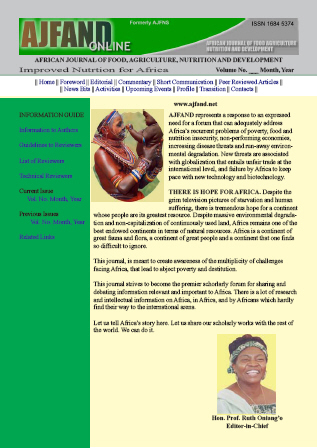
|
African Journal of Food, Agriculture, Nutrition and Development
Rural Outreach Program
ISSN: 1684-5358
EISSN: 1684-5358
Vol. 13, No. 5, 2013, pp. 8209-8223
|
 Bioline Code: nd13080
Bioline Code: nd13080
Full paper language: English
Document type: Research Article
Document available free of charge
|
|
|
African Journal of Food, Agriculture, Nutrition and Development, Vol. 13, No. 5, 2013, pp. 8209-8223
| en |
FOOD SECURITY STATUS OF RURAL FARMING HOUSEHOLDS IN IWO, AYEDIRE AND AYEDAADE LOCAL GOVERNMENT AREAS OF OSUN STATE, SOUTH-WESTERN NIGERIA
Adeniyi, Olawamiwa Reuben & Ojo, Oluwatobi Ayanlere
Abstract
This research work reports on the food security status of rural farming households in
selected Local Government Areas (LGA’s) of Osun State in the South-west Geopolitical
zone of Nigeria. The objectives were to estimate extent and magnitude of
food insecurity in the study area and determine factors that affect household food
security. Three of the thirty LGA’s were selected using stratified random sampling
method, based on the geographical location, extent and number of rural population
and variations in the socio-economic characteristics of households. The LGA’s were
Iwo, Ayedaade and Ayedire. Fifty rural households were then selected from each of
the local governments using the random sampling method. One hundred and fifty
copies of the questionnaire were administered out of which 103 fully completed and
certified responses were used as representative samples for the study area. Food
security status of the households was analyzed based on the calorie requirement for all
household members. The food security measures applied in this research were Head
Count Method, Food Insecurity Gap and Squared Food Insecurity Gap to capture
successively more detailed aspects of the food insecurity status of the households. It
was found that majority of the rural farming households in the area were food
insecure as most of them subsist below the food security line which is 2,280 Kcal in
this study. Using the recommended calorie approach, it was discovered that 69.9% of
the population were food insecure. In comparison to food insecure households, food
secure households have a small family size, earn a high monthly income and make
use of modern farm inputs. It is, therefore, advised that food security policy strategies
to be put in place by the government should consider the socio-economic
characteristics of households in order to achieve more than a marginal reduction in the
number of food insecure households.
Keywords
Households; Rural; Food; Index; Insecurity-gap
|
| |
© Copyright 2013 - African Journal of Food, Agriculture, Nutrition and Development
Alternative site location: http://www.ajfand.net/
|
|
